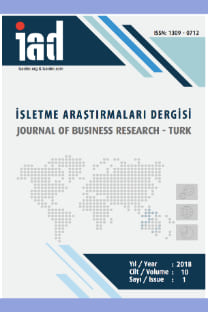LPI Based Two Stage Network DEA Model to Measure Logistics Efficiency:An Application on OECD Countries
LPI Based Two Stage Network DEA Model to Measure Logistics Efficiency:An Application on OECD Countries
___
- Aigner, D.J. and Chu, S.F. (1968). “On Estimating the Industry Production Function”, American Economic Review, 58(4), 826-839.
- Aigner, D.J., Lowell, C.A.K., and Schmidt, P. (1977). “Formulation and Estimation of Stochastic Frontier Production Function Models”, Journal of Econometrics, 6(1), 21-37.
- Andersen, P., and Petersen, N.C. (1993). “A Procedure for Ranking Efficient Units in Data Envelopment Analysis”, Management Science, 39, 1261-1264.
- Andrejić, M.M., and Kilibarda, M.J. (2016). “Measuring Global Logistics Efficiency Using PCA-DEA Approach”, Tehnika, 71(5), 733-740.
- Arvis, J.F., Ojala, L., Wiederer, C., Shepherd, B., Raj, A., Dairabayeva, K., and Kiiski, T. (2018). Connecting to Compete 2018, Trade Logistics in the Global Economy, The Logistics Performance Index and Its Indicators, available at: https://openknowledge.worldbank.org/bitstream/handle/10986/29971/LPI2018.pdf (accessed 30 August 2020)
- Banker, R.D., Charnes, A., and Cooper W.W. (1984). “Some Models for Estimating Technical and Scale Inefficiencies in Data Envelopment Analysis”, Management Science, 30, 1078-1092.
- Bramel, J., and Simchi-Levi, D. (1997). The Logic of Logistics: Theory, Algorithms, and Applications for Logistics Management, New York, Springer-Verlag.
- Charnes, A., Cooper W.W., and Rhodes E.L. (1978). “Measuring the Efficiency of Decision Making Units”, European Journal of Operational Research, 2, 429-444.
- Charnes, A., Cooper, W.W., Golany, B., Seiford, L.M., and Stutz, J. (1985). “Foundations of Data Envelopment Analysis and Pareto-Koopmans Empirical Production Functions”, Journal of Econometrics, 30, 91-107.
- Chiu, Y.H., and Huang, C.W. (2011). “Evaluating the Optimal Occupancy Rate, Operational Efficiency, and Profitability Efficiency of Taiwan’s International Tourist Hotels”, Service Industries Journal, 31, 2145-2163.
- de Mateo, F., Coelli, T., and O’Donnell C. (2006). “Optimal Paths and Costs of Adjustment in Dynamic DEA Models: With Application to Chilean Department Stores”, Annals of Operations Research, 145, 211-227.
- Deprins, D., Simar, L., and Tulkens, H. (1984). Measuring Labor Inefficiency in Post Offices, Marchand, M., Pestieau, P., and Tulkens, H. (Ed.), The Performance of Public Enterprises: Concepts and Measurements, Amsterdam, North-Holland, 243-267.
- Färe, R., and Grosskopf, S. (1996). Intertemporal Production Frontiers: With Dynamic DEA, Boston, Kluwer Academic Publishers.
- Färe, R., Grosskopf, S., Norris, M., and Zhang, Z. (1994). “Productivity Growth, Technical Progress, and Efficiency Change in Industrialized Countries”, The American Economic Review, 84(1), 66-83.
- Kao, C. (2009). “Efficiency Decomposition in Network Data Envelopment Analysis: A Relational Model”, European Journal of Operational Research, 192, 949-962.
- Kao, C. (2012). “Efficiency Decomposition for Parallel Production Systems”, Journal of the Operational Research Society, 63, 64-71.
- Kao, C. (2014). “Network Data Envelopment Analysis: A Review”, European Journal of Operational Research, 239, 1-16.
- Lovell, C.A.K., Pastor, J.T., and Turner, J.A. (1995). “Measuring Macroeconomic Performance in the OECD: A Comparison of European and Non-European Countries”, European Journal of Operational Research, 87(3), 507-518.
- Mariano, E.B., Gobbo Jr., J.A., de Castro Camioto, F., and do Nascimento Rebelatto, D.A. (2017). “CO2 Emissions and Logistics Performance: A Composite Index Proposal”, Journal of Cleaner Production, 163, 166-178.
- Markovits-Somogyi, R., and Bokor, Z. (2014). “Assessing the Logistics Efficiency of European Countries by Using the DEA-PC Methodology”, Transport, 29(2), 137-145.
- Marti, L., Martin, J.C., and Puertas R. (2017). “A DEA-logistics performance index”, Journal of Applied Economics, 20(1), 169-192.
- Meeusen, W. and van Den Broeck, J. (1977). “Efficiency Estimation from Cobb-Douglas Production Functions with Composed Error”, International Economic Review, 18(2), 435-444.
- Rashidi, K., and Cullinane, K. (2019). “Evaluating the Sustainability of National Logistics Performance Using Data Envelopment Analysis”, Transport Policy, 74, 35-46.
- Seiford, L.M., and Zhu, J. (1999). “Profitability and Marketability of the Top 55 US Commercial Banks”, Management Science, 45, 1270-1288.
- Sexton, T.R., Silkman, R.H., and Hogan, A.J. (1986). Data envelopment analysis: Critique and extensions, Silkman, R.H. (Ed.), Measuring Efficiency: An Assessment of Data Envelopment Analysis, San Fransisco, Jossey Bass and American Evaluation Association, 73-105.
- Sheth, C., Triantis, K., and Teodorović, D. (2007). “Performance Evaluation of Bus Routes: A Provider and Passenger Perspective”, Transportation Research Part E: Logistics and Transportation Review, 43, 453-478.
- Tone, K. (2001). “A Slacks-Based Measure of Efficiency in Data Envelopment Analysis”, European Journal of Operational Research, 130, 498-509.
- Tsai, W.H., Lee, H.L., Yang, C.H., and Huang, C.C. (2016). “Input-Output Analysis for Sustainability by Using DEA Method: A Comparison Study between European and Asian Countries”, Sustainability, 8(12), 1-17.
- UNCTAD, United Nations. (2020). World Economic Situation and Prospects 2020, available at: https://unctad.org/system/files/official-document/wesp2020_en.pdf (accessed 30 August 2020).
- Yang, F., Wu, D., Liang, L., Bi, G., and Wu D.D. (2011). “Supply Chain DEA: Production Possibility Set and Performance Evaluation Model”, Annals of Operations Research, 185, 195-211.
- Yu, M.M. (2008). “Assessing the Technical Efficiency, Service Effectiveness, and Technical Effectiveness of the World’s Railways through NDEA Analysis”, Transportation Research Part A: Policy and Practice, 42, 1283- 1294.
- Yu, M.M., and Chen P.C. (2011). “Measuring Air Routes Performance Using a Fractional Network Data Envelopment Analysis Model”, Central European Journal of Operations Research, 19, 81-98.
- ISSN: 1309-0712
- Yayın Aralığı: 4
- Başlangıç: 2009
- Yayıncı: Melih Topaloğlu
İmalat İşletmelerinde Maliyet ve Performans Planlamasına İlişkin Bir Uygulama
Yıkıcı Yönetim Algısı: Demografik Değişkenlere Göre Bankacılık Sektöründe BirAraştırma
Sefer AYDOĞAN, Fatma KUTLU GÜNDOĞDU
Akıllı Telefon Bağımlılığının Çalışanların İş Tatminleri Üzerine Etkisi
Mahmut ÖZDEMİR, Nurcan ÇETİNER
Olca SEZEN DOĞANCILI, Handan ÖZÇELİK BOZKURT
Nüfer Yasin ATEŞ, Nathalie PASMAN
Kurum İçi İletişimin Kurumsal Bağlılık Üzerine Etkisi ve Bir Kamu KurumuUygulaması
Repeated Partnerships and Radical Innovation: Evidence from Wireless GamingMarket
Feray ADIGÜZEL, Kerem GÜRSES, Pınar ÖZCAN
Entelektüel Sermayenin İşletmelerin Verimliliğine Etkilerine Yönelik Bir Araştırma
